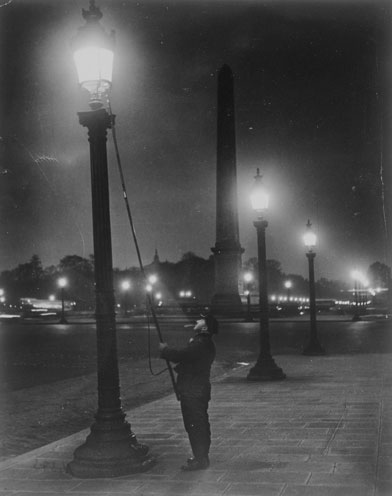Fr : version française / En: english version
Let there be light!
City streets were not known for their safety—some were even reputed to be death traps. To offset this feeling of insecurity, a campaign was launched in the 16th century to improve street lighting, leading to the creation of a new profession: the lamplighter. The fuel used in these lamps varied over time, ranging from tallow and candles to oil and gas.
The fifth planet
The fifth planet was very strange. It was the smallest of all. There was just enough room on it for a street lamp and a lamplighter. The little prince was not able to reach any explanation of the use of a street lamp and a lamplighter, somewhere in the heavens, on a planet which had no people, and not one house. But he said to himself, nevertheless:
"It may well be that this man is absurd. But he is not so absurd as the king, the conceited man, the businessman, and the tippler. For at least his work has some meaning. When he lights his street lamp, it is as if he brought one more star to life, or one flower. When he puts out his lamp, he sends the flower, or the star, to sleep. That is a beautiful occupation. And since it is beautiful, it is truly useful."
When he arrived on the planet he respectfully saluted the lamplighter.
"Good morning. Why have you just put out your lamp?"
"Those are the orders," replied the lamplighter. "Good morning."
"What are the orders?"
"The orders are that I put out my lamp. Good evening."
And he lighted his lamp again.
"But why have you just lighted it again?"
"Those are the orders," replied the lamplighter.
"I do not understand," said the little prince.
"There is nothing to understand," said the lamplighter. "Orders are orders. Good morning."
And he put out his lamp...
"That man," said the little prince to himself, as he continued farther on his journey, "that man would be scorned by all the others: by the king, by the conceited man, by the tippler, by the businessman. Nevertheless he is the only one of them all who does not seem to me ridiculous. Perhaps that is because he is thinking of something else besides himself."
Extract from The Little Prince by Antoine de Saint-Exupéry, 1943
Gaslights appeared in the streets of Paris in the early 19th century. Lamplighters worked 12 hours a day, seven days a week. In addition to lighting and snuffing out the lamps, it was their job to control the gas supply to customers until the electricity fairy waved her magic wand and put them all out of a job.
Brighter prospects?
There have been no lanterns for 16 years now. They have been replaced by streetlamps. In the past, eight thousand lanterns with their awkwardly fixed candles—blown out or made to run in the wind—served to cast a poor, pale, wavering light in the streets, interspersed by dangerous, shifting shadows.
Nowadays, we have found a way to cover the city in better light while making the whole process easier for all. The combined lights from 12 hundred streetlamps give off a steady, bright, lasting light.
But why such parsimony with regard to this new institution? The streetlamps are turned off on days when there is a moonlit sky, yet before the moon appears on the horizon, the darkest night has already blanketed the streets; and when the moon shines overhead, the height of the houses still intercepts the rays of light from the astral body and its torch is rendered useless.
When it sets, the same problems arise, and Paris is again plunged into the most dangerous shadow.
Streetlamps used animal oil produced at a factory on Ile des Cygnes.
Extract from Louis-Sébastien Mercier's "Tableaux de Paris", 1783. (Free translation from the French)
Nowadays, astronomers complain that they can no longer see the night sky because of the veil cast over the stars by light pollution from cities.



























